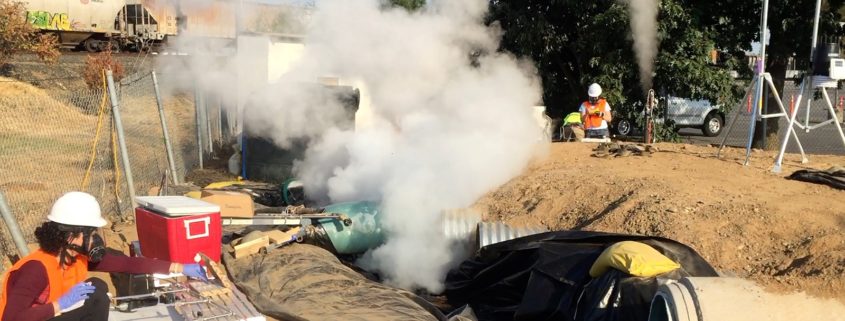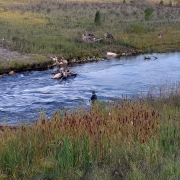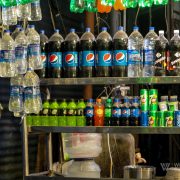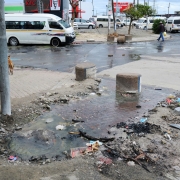When the Sewer Pipe Breaks, Watch Out For What Comes Next
Toxic emissions from common pipe repair are a health risk, researchers say.
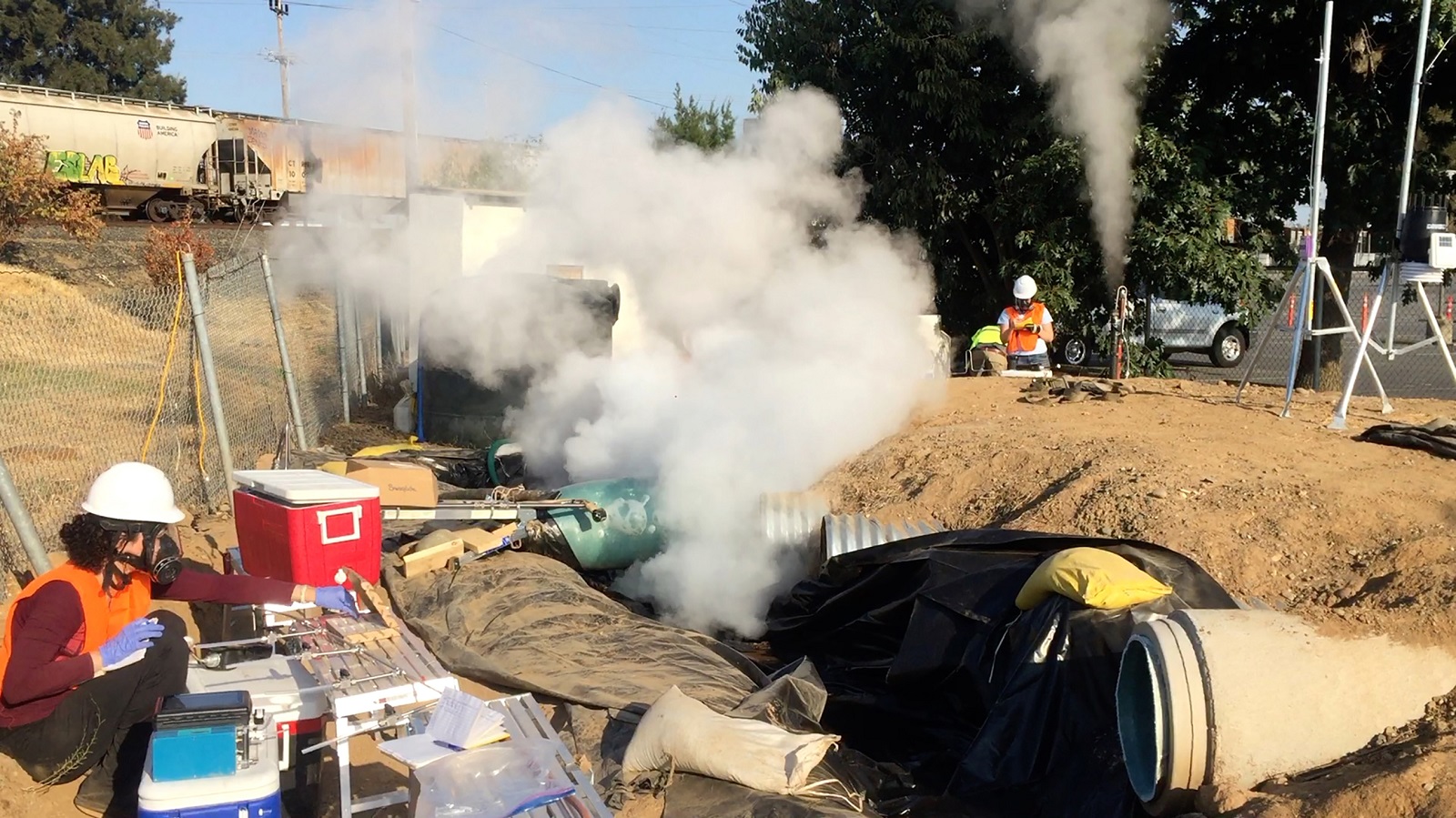
Purdue researchers test pipe emissions at a study site in California during a CIPP installation. Photo courtesy of Purdue University
By Brett Walton, Circle of Blue
Just before lunch on September 21, the San Diego Fire-Rescue Department responded to a report of three dozen ill students at Zamorano Fine Arts Academy, an elementary school in the Bay Terraces neighborhood.
The students were the latest group in the United States to react to noxious emissions from a nearby municipal construction site. The kids, one of whom was taken to the hospital for observation, had breathed fumes from a sewer line replacement taking place on Casey Street, adjacent to the school’s main entrance. The contractors hired by the city were using a method called cured-in-place pipe, or CIPP, to repair the line. CIPP is a cloth liner laced with plastic resins that is inserted into a deteriorated pipe. Steam, hot water, or ultraviolet light hardens the resin and results in a new pipe within the old pipe.
CIPP technology has been around for four decades, and it is popular. Utilities prefer CIPP because they can fix broken pipes without ripping up city streets. It’s cheaper and faster. From an axle in the back of a cargo truck raw CIPP liner unspools into an open manhole like stretched taffy. Usually made of polyester, fiberglass, or felt that is saturated with plastic resins, the liners can fit pipes more than eight feet in diameter.
Roughly half of all damaged sewer and stormwater pipes in the United States are repaired using CIPP, according to an industry survey. The increasing age of water utility pipes is expanding the business. Stratview Research, a market analyst, forecasts that global CIPP sales will be $2.5 billion a year by 2022, with North America the largest market.
Utilities and local authorities often tell residents near CIPP work sites not to be concerned about odors, calling the “steam” that billows from manholes covers harmless, temporary, and safe. A recent study, however, found plenty of cause for concern.
In an assessment of air emissions from sewer and stormwater repair sites in California and Indiana, a Purdue University research team found that the steam is not simply water vapor. It is a mixture of water vapor, solvents, uncured resin droplets, and plastic particles such as styrene, benzaldehyde, butylated hydroxytoluene, and other compounds that the researchers could not identify. Besides headaches and dizziness, some of these compounds are suspected to cause cancer and interfere with the body’s hormonal system. The study was published in July in the journal Environmental Science and Technology Letters.
“The emissions from steam-cured CIPP sites are not steam. There are multiple materials that are created and emitted into the air,” Andrew Whelton, an environmental engineer and lead author of the study, told Circle of Blue.
Much is unknown about CIPP emissions, which worries Whelton and a growing number of public health professionals. There are no workplace safety regulations regarding CIPP installation and no health studies at all to determine short-term and long-term damage to workers or residents exposed to the fumes. “We need a lot more investigation of this,” said Sandra Whitehead, a program manager with the National Environmental Health Association.
Evidence of the health risks associated with CIPP is accumulating. In May, two people in South Pasadena, California, were taken to the hospital for nausea due to breathing noxious fumes. Authorities blamed the incident on nearby sewer work.
In Nyack, New York, in July, police and emergency responders were twice summoned by residents who described the scent of “airplane glue” near a sewer pipe replacement site. Medics supplied oxygen to one person who complained of dizziness.
Also in July, the California Department of Public Health released a safety alert that called CIPP installations “an under-recognized hazard” — and not only for workers at the site. Fumes can travel through sewer connections and emerge in nearby homes and businesses. The safety alert mentioned styrene fumes from a CIPP installation that migrated into an office building. Styrene was detected in the building for three months.
A National Problem
Whelton’s interest in the toxicity of pipe replacement technology began a few years ago when he was professor at the University of South Alabama. He was helping state transportation officials understand what chemicals were released into water before, during, and after CIPP installation. That study, published in 2014, found that the material that collects at the bottom of a cooled pipe was a mixture of solvents. The team exposed the mixture to a species of water flea typically used to test toxicity. The water flea dissolved within 24 hours.
“After I published that study people who claimed to have been exposed to chemicals due to cured-in-place pipe use started contacting me saying I was the only one with a study out there and reachable about CIPP and wanted to know if they were going to be OK, if their health would be affected,” Whelton recalled.
A family in Philadelphia with a newborn found Whelton’s contact information and called him. The parents told him that a white plume from sewer work came into the baby’s room and the baby started acting funny. “They wanted to know if everything would be OK because the contractor was saying, ‘It’s just steam, it’s harmless.’ So with that I tried to find ways to help people understand this technology.”
He’s been so dogged that Whelton is now recognized as the top American authority on CIPP risk. The National Institute for Occupational Safety and Health, the federal agency charged with studying workplace hazards, told Circle of Blue that questions about CIPP technology and health effects should be directed to Whelton because he knew more than they did.
In his work, Whelton flags news reports that mention “vapors” or “steam” emitted from pipe replacement. He found more than four dozen instances of businesses temporarily closing because of odors or residents in homes and schools near work sites being sickened after breathing in the particle cloud.
In Nashville, Tennessee, for example, residents near a CIPP work site complained of dizziness and trouble breathing In September 2014. The odor “coats the back of your throat,” one resident told a local television news reporter.
Whelton found only four studies in the last 16 years that examined the content of CIPP air emissions. A study in 2015 conducted by a graduate student found roughly 1,000 parts per million of styrene emitted in downtown Los Angeles from a sewer manhole. The level at which styrene emissions are an immediate risk to life and health is 700 parts per million, according to the National Institute for Occupational Safety and Health.
“The testing conducted in Los Angeles indicated that there may have been an imminent risk to worker safety at the site and none of the people including the student and workers were wearing any respiratory protection,” Whelton said.
The mounting evidence has begun to attract industry attention. The National Association of Sewer Service Companies, a trade group that holds training courses and sets standards, will fund a review of recent CIPP air emissions research, including Whelton’s study. The association is also seeking proposals to collect emissions data from work sites.
The nature of the work sites is a complicating factor, Whelton explained. Workers are mobile, staying at one site for a few hours or days to insert and cure the pipe and then moving to the next manhole or culvert.
Site conditions are always changing, he said. Pipes could be in relatively good condition or quite deteriorated. Does duration of curing affect emissions? The resins degrade into different chemical substances as they cure: what substances are they? Does air temperature or the condition of pipe play a role? He doesn’t know. “Whether those differences affect emissions is unknown because there hasn’t been any credible testing in the last 16 years associated with these types of factors, to understand them,” he said.
Whelton hopes that the study, which was funded by the National Science Foundation, is a starting point for more chemical and health investigations. With growing demand for pipe repairs, he does not believe that CIPP should be abandoned, but that oversight needs to be improved. Air at work sites should be monitored and workers should wear protective clothing and respirators. San Diego officials, for instance, are reviewing city policies so that an incident like the sickened elementary school children does not happen again.
Above all, Whelton said, the white cloud shouldn’t be allowed to leave the site. The particles and vapors should be captured and disposed of. “If you want to make the technology safer, then remove the emissions issue,” he said.
Brett writes about agriculture, energy, infrastructure, and the politics and economics of water in the United States. He also writes the Federal Water Tap, Circle of Blue’s weekly digest of U.S. government water news. He is the winner of two Society of Environmental Journalists reporting awards, one of the top honors in American environmental journalism: first place for explanatory reporting for a series on septic system pollution in the United States(2016) and third place for beat reporting in a small market (2014). He received the Sierra Club’s Distinguished Service Award in 2018. Brett lives in Seattle, where he hikes the mountains and bakes pies. Contact Brett Walton

